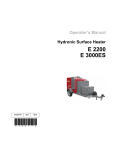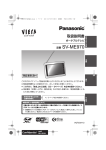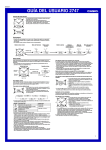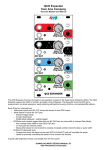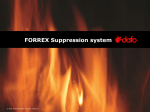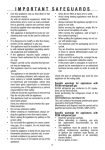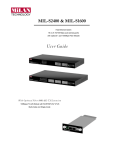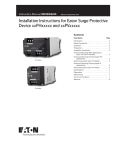Download Motion 42-02-S028 User guide
Transcript
Motion Control Engineering, Inc. 11380 White Rock Road Rancho Cordova, CA 95742 voice 916 463 9200 fax 916 463 9201 www.mceinc.com User Guide, Universal Serial Network Manual # 42-02-S028, Rev A1, December 2008 Copyright © 2008, Motion Control Engineering. All Rights Reserved. This document may not be reproduced, electronically or mechanically, in whole or in part, without written permission from Motion Control Engineering. Trademarks All trademarks or registered product names appearing in this document are the exclusive property of the respective owners. Warning and Disclaimer Although every effort has been made to make this document as complete and accurate as possible, Motion Control Engineering and the document authors, publishers, distributors, and representatives have neither liability nor responsibility for any loss or damage arising from information contained in this document or from informational errors or omissions. Information contained in this document shall not be deemed to constitute a commitment to provide service, equipment, or software by Motion Control Engineering or the document authors, publishers, distributors, or representatives. Limited Warranty Motion Control Engineering (manufacturer) warrants its products for a period of 15 months from the date of shipment from its factory to be free from defects in workmanship and materials. Any defect appearing more than 15 months from the date of shipment from the factory shall be deemed to be due to ordinary wear and tear. Manufacturer, however, assumes no risk or liability for results of the use of the products purchased from it, including, but without limiting the generality of the forgoing: (1) The use in combination with any electrical or electronic components, circuits, systems, assemblies or any other material or equipment (2) Unsuitability of this product for use in any circuit, assembly or environment. Purchasers’ rights under this warranty shall consist solely of requiring the manufacturer to repair, or in manufacturer's sole discretion, replace free of charge, F.O.B. factory, any defective items received at said factory within the said 15 months and determined by manufacturer to be defective. The giving of or failure to give any advice or recommendation by manufacturer shall not constitute any warranty by or impose any liability upon the manufacturer. This warranty constitutes the sole and exclusive remedy of the purchaser and the exclusive liability of the manufacturer, AND IN LIEU OF ANY AND ALL OTHER WARRANTIES, EXPRESSED, IMPLIED, OR STATUTORY AS TO MERCHANTABILITY, FITNESS, FOR PURPOSE SOLD, DESCRIPTION, QUALITY PRODUCTIVENESS OR ANY OTHER MATTER. In no event will the manufacturer be liable for special or consequential damages or for delay in performance of this warranty. Products that are not manufactured by MCE (such as drives, CRTs, modems, printers, etc.) are not covered under the above warranty terms. MCE, however, extends the same warranty terms that the original manufacturer of such equipment provide with their product (refer to the warranty terms for such products in their respective manual). End User License Agreement This End User License Agreement (“Agreement”) grants you the right to use the software contained in this product (the “Software”) subject to the following restrictions: You may not: (i) copy the Software, except for archive purposes consistent with your standard archive procedures; (ii) transfer the Software to a third party apart from the entire product; (iii) modify, decompile, disassemble, reverse engineer or otherwise attempt to derive the source code of the Software; (iv) export the Software or underlying technology in contravention of applicable U.S. and foreign export laws and regulations; and (v) use the Software other than in connection with operation of the product. “LICENSOR'S SUPPLIERS DO NOT MAKE OR PASS ON TO END USER OR ANY OTHER THIRD PARTY, ANY EXPRESS, IMPLIED OR STATUTORY WARRANTY OR REPRESENTATION ON BEHALF OF SUCH SUPPLIERS, INCLUDING BUT NOT LIMITED TO THE IMPLIED WARRANTIES OF NON-INFRINGEMENT, TITLE, MERCHANTABILITY OR FITNESS FOR A PARTICULAR PURPOSE.” Important Precautions and Useful Information This preface contains information that will help you understand and safely maintain MCE equipment. We strongly recommend you review this preface and read this manual before installing, adjusting, or maintaining Motion Control Engineering equipment. This preface discusses: • • Safety and Other Symbol Meanings In This Guide Safety and Other Symbol Meanings Danger This manual symbol is used to alert you to procedures, instructions, or situations which, if not done properly, might result in personal injury or substantial equipment damage. Caution This manual symbol is used to alert you to procedures, instructions, or situations which, if not done properly, might result in equipment damage. Note This manual symbol is used to alert you to instructions or other immediately helpful information. Contents In This Manual . . . . . . . . . . . . . . . . . . . . . . . . . . . . . . . . . . . . . . . . . . . . . . . . . . . . . . .1 USN Installation . . . . . . . . . . . . . . . . . . . . . . . . . . . . . . . . . . . . . . . . . . . . . . . . . . . . . 2 IMC, PTC, PHC Installation . . . . . . . . . . . . . . . . . . . . . . . . . . . . . . . . . . . . . . . . . . . . . . . . . . . . 2 Mounting the Board Assemblies . . . . . . . . . . . . . . . . . . . . . . . . . . . . . . . . . . . . . . . . . . . . . . 3 Motion 3000ES Installation . . . . . . . . . . . . . . . . . . . . . . . . . . . . . . . . . . . . . . . . . . . . . . . . . . . . 3 Mounting the Board Assemblies . . . . . . . . . . . . . . . . . . . . . . . . . . . . . . . . . . . . . . . . . . . . . . 3 USN Power Connection, Elevators . . . . . . . . . . . . . . . . . . . . . . . . . . . . . . . . . . . . . . . . . . . . . . . 3 Power Connection, Escalators . . . . . . . . . . . . . . . . . . . . . . . . . . . . . . . . . . . . . . . . . . . . . . . . . . 3 Configuration . . . . . . . . . . . . . . . . . . . . . . . . . . . . . . . . . . . . . . . . . . . . . . . . . . . . . . . 4 Device Type . . . . . . . . . . . . . . . . . . . . . . . . . . . . . . . . . . . . . . . . . . . . . . . . . . . . . . . . . . . . . . . . . . 4 Escalator Only . . . . . . . . . . . . . . . . . . . . . . . . . . . . . . . . . . . . . . . . . . . . . . . . . . . . . . . . . . . . . . . 5 IP Setup . . . . . . . . . . . . . . . . . . . . . . . . . . . . . . . . . . . . . . . . . . . . . . . . . . . . . . . . . . . . . . . . . . . . . 5 Important . . . . . . . . . . . . . . . . . . . . . . . . . . . . . . . . . . . . . . . . . . . . . . . . . . . . . . . . . . . . . . . . . 5 Communication Connections . . . . . . . . . . . . . . . . . . . . . . . . . . . . . . . . . . . . . . . . . . 6 IMC . . . . . . . . . . . . . . . . . . . . . . . . . . . . . . . . . . . . . . . . . . . . . . . . . . . . . . . . . . . . . . . . . . . . . . . . 6 PTC/PHC . . . . . . . . . . . . . . . . . . . . . . . . . . . . . . . . . . . . . . . . . . . . . . . . . . . . . . . . . . . . . . . . . . . 7 Motion 3000ES . . . . . . . . . . . . . . . . . . . . . . . . . . . . . . . . . . . . . . . . . . . . . . . . . . . . . . . . . . . . . . 8 MC USN Information . . . . . . . . . . . . . . . . . . . . . . . . . . . . . . . . . . . . . . . . . . . . . . . . . 9 Jumper Settings . . . . . . . . . . . . . . . . . . . . . . . . . . . . . . . . . . . . . . . . . . . . . . . . . . . . . . . . . . . . . . 9 Diagnostic LEDs . . . . . . . . . . . . . . . . . . . . . . . . . . . . . . . . . . . . . . . . . . . . . . . . . . . . . . . . . . . . . . 9 LCD and Keypad . . . . . . . . . . . . . . . . . . . . . . . . . . . . . . . . . . . . . . . . . . . . . . . . . . . . . . . . . . . . 10 Operating Displays . . . . . . . . . . . . . . . . . . . . . . . . . . . . . . . . . . . . . . . . . . . . . . . . . . . . . . . . . . . 10 Troubleshooting. . . . . . . . . . . . . . . . . . . . . . . . . . . . . . . . . . . . . . . . . . . . . . . . . . . . . . . . . . . 11 Diagnostic Menus . . . . . . . . . . . . . . . . . . . . . . . . . . . . . . . . . . . . . . . . . . . . . . . . . . . . . . . . . . . 11 Configuration Menus . . . . . . . . . . . . . . . . . . . . . . . . . . . . . . . . . . . . . . . . . . . . . . . . . . . . . . . . . 12 Security Password Default for IMC Connections . . . . . . . . . . . . . . . . . . . . . . . . 13 KCE Functionality . . . . . . . . . . . . . . . . . . . . . . . . . . . . . . . . . . . . . . . . . . . . . . . . . . 13 i ii Manual # 42-02-S028, 12/30/08 • • • • • • Installation Configuration Communication Connect MC USN Information Security Password IMC KCE Functionality MCE Universal Serial Network In This Manual This manual describes installing and setting up the MCE Universal Serial Network product. The USN is used to allow equipment without appropriate networking capabilities to communicate with state-of-the-art, MCE software applications including iMonitor, iReport, and BMS-Link. • • • • • • Installation Configuration Communication Connections MC USN Information Security Password Default for IMC KCE Functionality 1 MCE Universal Serial Network USN Installation Installation instructions include: • MCE IMC and PTC/PHC Controls • Motion 3000ES Escalator Controls • USN Power Connection Note After mounting USN components in your equipment, ensure that no serial, ethernet, or CAN connections are made to the device. Only power should be connected during initial setup. IMC, PTC, PHC Installation The Universal Serial Network (USN) converts legacy MCE communication protocols to the latest MCE monitoring, reporting, and building management compatible protocols. For IMC, only the USN-BASE assembly and power transformer are required. For programmable (PTC/PHC) controllers, one M2C assembly is required for each controller in addition to the USN-BASE assembly and power transformer. CAN 2 AC1/AC2 Port B J7 PCA JP3 Ethernet Port A J5 USN-BASE Assembly Power transformer 6-feet power leads are provided but are not connected to the transformer. Cut leads to length required and connect to transformer per local requirements. 2 Manual # 42-02-S028 A1 M2C Assembly USN Installation Mounting the Board Assemblies 1. Determine an appropriate location for the USN-BASE assembly. (Preferred location is in the upper left quadrant of the control enclosure.) 2. Mount the board, facing outward, such that access to critical controller components is not blocked. 3. For PTC/PHC programmable controllers, mount the M2C assembly near the USN-BASE assembly. (For a duplex, mount an M2C assembly in each controller enclosure but just one USN-BASE assembly in the enclosure of your choice.) Motion 3000ES Installation For Motion 3000ES, only the USN-BASE assembly is required. Special hinged stand-offs will be provided to mount the USN-BASE (HC-MPU) board assembly. Mounting the Board Assemblies 1. Determine an appropriate location for the USN-BASE assembly. 2. Mount the board, facing outward, such that access to critical controller components is not blocked. USN Power Connection, Elevators Before the USN can be configured, it must be powered up. But, no communication connections, serial, Ethernet, or CAN, should yet be attached. 1. Connect the provided leads to the power transformer. 2. Connect the power transformer leads to AC1/AC2 on the top right side of the USN-BASE assembly. 3. Plug the power transformer into the AC receptacle in the controller. (Note: If alternate outlet is used, power must be in phase with controller 110 VAC.) Power Connection, Escalators The power transformer is not required for Motion 3000ES escalator installations. 1. Using 18 AWG, white, teflon coated wires, connect HC-MPU, 16V1 to escalator board EC-MCB, CL1 and HC-MPU, 16V2 to EC-MCB CH1. 3 MCE Universal Serial Network Configuration After connecting power, “INITIALIZING BOARD COMM” will appear on the USN-BASE assembly LCD display. Device Type Note It is important that all communication wires are disconnected from the USN board before changing the device type. Make sure all ethernet, CAN, and serial cables are disconnected. When making changes to settings: • • • • • • Press N to cycle through menu Press S to select Use S to move cursor Use +/- to change selection Press N to go to save menu Press S to save To begin configuration: 1. Set only the F7 switch UP. 2. Press N until Device Type is displayed. 3. Press S to select. Supported Device Types are: • IMC types: • Swing Panel Group • Swing Panel Simplex • PCA types: • PHC Simplex Standard • PHC Simplex Ansi 2000 • PHC Duplex Standard • PHC Duplex Ansi 2000 • PTC Simplex Standard • PTC Simplex Ansi 2000 • PTC Duplex Standard • PTC Duplex ASME 2000 • Motion 3000ES Escalator Controller 4. Select the Device Type. 5. Press N to go to save menu. Press S to save. 6. After the device type has changed, place the F7 switch down. 7. Reset the USN board by pressing the RSTA button. 8. After the device reboots, confirm new device type is selected. 4 Manual # 42-02-S028 A1 Configuration Escalator Only If you are not configuring an escalator, proceed to IP Setup. An escalator connection has additional parameters that need to be configured. Please note: each escalator must have its own unique lift number. 1. Place switch F7 in the up position. Using the keypad as described earlier, set and save: • Job Name: Defines the job name displayed on the iMonitor Summary screen. • Job Number: Defines the job number displayed on iMonitor Summary screen. • Number of Escalators: Defines the number of escalators the USN will be monitoring on the CAN bus. • If only one escalator is to be connected to the USN, choose the 1 (AUTO) setting. This setting assumes that only one escalator will be connected to the USN board and it will automatically detect the lift number on the bus. • If more than one escalator is on the bus the USN will connect to the first one it sees. Since detection is automatic the Escalator Connection menu is not shown. • Escalator Connection: The USN has the ability to group up to 4 escalators in a group. This parameter maps the lift number that will be the first escalator in the group, second escalator, and so on. • Escalator Label: This two-character value will be displayed in iMonitor under the escalator grouping. For example, you could set lift 2 to display as “E2”. 2. Proceed to IP Setup. IP Setup You may need to consult an IT person to find out the appropriate IP settings for your network. With the F7 switch in the up position, set: • • • • IP Address Subnet Mask Gateway Address Other options (MCE use only) Important • After defining network settings, you must reset the USN board by disconnecting and reconnecting the IDC power connector. 5 MCE Universal Serial Network Communication Connections Connections are described for IMC, PTC/PHC, and Motion 3000ES. IMC 1. Connect the external Ethernet cable to Ethernet Port A on the USN-BASE assembly. 2. Connect the supplied C-RJ11/DB9M cable from a controller MC-RS (serial board) COM port to RS232 Port B (J7) on the USN-BASE assembly. 3. Through the controller MPU board, set the connected COM port to media= serial and device= PC. 4. On the MC-RS board, set the connected COM port slide switch to DCE. 5. Press RSTA to reset the USN board so that it will read its new connections. If connecting an IMC group control: IMC: MC-RS Board 1. Connect to the group controller using a CRT, terminal emulator, or TigerTerm software. 2. Press F1, then 1 to get to the General configuration screen. 3. Access the ICOM setting. Set it to the COM port connected to the MC-USN board. For example, if the MCUSN board is connected to COM2 on the MC-RS board, set the ICOM setting to COM2. 4. Save. 5. With the Function Switch F8 switch UP (all others down), press N to cycle through the menu to verify that information is correct. • MC-USN version • iReport version • Number of cars connected • Number of cars • Number of floors The controller is now ready to communicate. 6 Manual # 42-02-S028 A1 Communication Connections PTC/PHC 1. Connect the external Ethernet cable to Ethernet Port A on the USN-BASE assembly. 2. The boards in the controller are connected along a ribbon cable bus. Connect the M2C assembly’s “From PCA” (JP3) to the last controller board on the bus using supplied ribbon cable. The last board on the ribbon cable bus will have an empty socket. Make the connection from this socket. 3. Connect the M2C assembly’s CAN2 port to the “Internal Network” (J5) connector on the USN-BASE assembly using the C-RJ-11 cable . 4. For Duplex, connect both CAN2 ports on the M2C assembly to supplied splitter. Then plug the splitter into “Internal Network” (J5) connector on USN-BASE assembly. 5. Press RSTA to reset the USN board so that it will read its new connections. 6. With the Function Switch F8 switch UP (all others down), press N to cycle through the menu to verify that information is correct. • MC-USN version • iReport version • Number of cars connected • Number of cars • Number of floors The controller is now ready to communicate. 7 MCE Universal Serial Network Motion 3000ES 1. Connect the CAN bus wires from the three-wire terminal on lower right side of the HCMPU (USN) board labeled “External Network” to escalator EC-MCB board, J12. • Connect CAN H to J12 TB. • Connect CAN L to J12 TA. • The SHLD is only connected on the HC-MPU (USN) side. 2. Press RSTA to reset the USN board so that it will read its new connections. 8 Manual # 42-02-S028 A1 MC USN Information MC USN Information This section describes the features of the USN device. Jumper Settings These jumper settings apply to the Rev X3-0 version of the MPU-M board. • • • • • • • JP1 = A (5V) JP2 = Off JP3 = ON JP4 = Off JP5 = A (NORM) JP6 = Off JP7 = Off Diagnostic LEDs Client Connected Client Connected Client Connected Client Connected Client Connected Client Connected At least one device connected Receiving data from Internal Network connector (PTC/PHC) Receiving data from External Network connector (Escalator) Receiving data from RS-232B connector (IMC) Main software loop light 500msec toggle light The diagnostic leds on the USN board show the health of the system at a glance. The USN board is used in several MCE product lines and is permanently labeled according to its primary application. Disregard the LED labels on the board. Instead, refer to the following illustration: 9 MCE Universal Serial Network LCD and Keypad • Trim pot R27 adjusts LCD screen contrast. • The interface uses eight functional switches and 4 buttons. Operating Displays Upon initial power-up, the board should display the following message: If the display never changes from this message, verify that the SW1 switch is in the down (ETHERNET PORT A) position. After approximately four seconds it should display: Or, WAITING FOR ESC COMMUNICATION for escalators, with a progress bar to indicate the initial data request. 10 Manual # 42-02-S028 A1 MC USN Information Once the USN has connected to the device it will display the following message: This indicates that the USN board has successfully established connectivity with the device. If the following message is displayed: The USN board is not receiving data from the device. Troubleshooting • Recheck you connections to the board. Ensure that all proper connections have been made based on the device type. • In the case of a PCA type controller, ensure that the JP5 jumper on the M2C board is on pins 2 and 3 (closest to the edge of the board). • In the case of a swing panel, ensure that the slide switch on the MC-RS board is in the DCE position and that the ICOM setting is configured for the correct COM port. • If this job is a modification, ensure that the updated CGPC or PCA chips have been installed into the controller. Diagnostic Menus To access diagnostic menus, place (only) the F8 switch in the UP position. This menu is used primarily by MCE technicians for diagnostic purposes. • Version screen: Displays the MC-USN version. • iReport Connection Screen: This option shows information related to iReport connectivity. When connected, the iReport TCP port number, connection state, and IP address are displayed. • Number of Xport Resets: This option displays the number of Xport resets since the last time the board was reset. Excessive resets may indicate a network-related issue. • Device Communication Queue Health: This option displays the highest number of bytes sent by the connected controller device that had to be stored before processing. It also displays the maximum number of bytes that can be stored. The final number is a real-time display of the number of bytes buffered before processing. If current number of buffered bytes is the same as the max then the device has sent data too quickly for the USN to process. MCE use only. 11 MCE Universal Serial Network • Translation Loop Progress: This screen displays the progress of translating events, parameters, and monitors from the device protocol to the client protocol. MCE use only. • Internal Address Data Values: This option is used to dial USN memory addresses and view their contents. The functional switches and buttons are used in this mode to change the format of the information displayed. • If switches F1, F2 and F3 are in the down position, data is displayed in Binary (Base 2) format. • Switch F1: Flip this switch up to display data in ACII format. • Switch F2: Flip this switch up to display data in Hexadecimal (Base 16) format. • Switch F3: Flip this switch up to display data in Decimal (Base 10) format. • Switch F4: If this switch is down, snapshot of the current memory address is displayed. If this switch is up, a real-time display of the current address is displayed. • S button: Enter edit mode. Press S to move cursor. Press + and - button to increment/ decrement digit selected by cursor. Configuration Menus • Device Type: This menu is used to select the type of controller the USN will connect to. • IP Address: This menu is used to assign an IP address to the USN interface board. Typically, MCE uses IP addresses in the range of 192.168.191.XXX. Consult the building IT department for more information. Note The IP address must be unique on the network. If another device shares the same address and the USN is connected to the network, the USN board may be rendered inoperable. Should this occur, please consult MCE technical support. • Subnet Mask: This menu is used to assign the subnet mask for the USN interface board. Typically, MCE uses subnet mask 255.255.255.0. Consult the building IT department for more information. • Gateway Address: This menu is used to assign the default gateway address for the USN interface board. The gateway address is the IP address of the nearest available router. This setting is used in more complex networking environments to route between different networks. Generally this can be left as 000.000.000.000. Consult the building IT department for more information. • Reset Xport: This option will reset the ethernet interface of the USN. Press the S key to activate. • Refresh Device: This option causes the USN to refresh all data from the connected controller device. Press the S key to activate. • Refresh Xport: This option causes the ethernet interface to refresh all saved parameters. Press the S key to activate. • TFTP Status: Press the S key to enable the embedded TFTP service. This is used to upgrade the Xport ethernet interface using the device installer software. 12 Manual # 42-02-S028 A1 Security Password Default for IMC Connections Security Password Default for IMC Connections If the USN is connected to an IMC controller with the CRT Security feature enabled, the USN will allow iMonitor software to configure security parameters. In order to configure security parameters, a user must log into the controller using a password. This password is stored on the USN board. The default password is “manager”. If it is lost, the password can be reset back to default: 1. Disconnect the serial communication cable from the USN. 2. Change the Device type setting from Swing Panel to a non-swing panel type (e.g. PCA Simplex A2K) and save. 3. Reset board by pressing the RSTA button. 4. Change Device type back to Swing Panel and save. 5. Remove power from USN. 6. Reconnect serial communication cable. 7. Reconnect power to USN. KCE Functionality In order to utilize car recall functionality with iMonitor software, the KCE (Keyboard Control for Elevators) feature must be enabled on the controller. On PCA-type controllers, activate KCE from the Extra Features menu. Please consult the appropriate controller documentation for details. On IMC-type controllers, the KCE feature must be pre-programmed on the controller software. You can verify the presence of the KCE feature by connecting to the group controller using a CRT, terminal emulator or TigerTerm software. Go to the Job Configuration screen (F6) and view the Other Options menu item. Please consult the appropriate controller documentation for more details. Note KCE functionality is available on only certain MCE controllers. Check the controller user manual. 13 MCE Universal Serial Network 14 Manual # 42-02-S028 A1





















